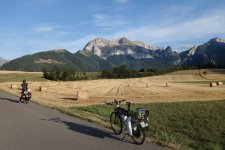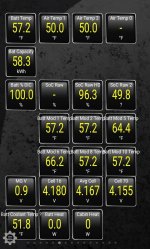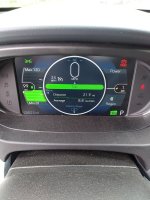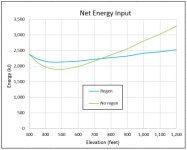Mahe said:Excellent thread, especially start and end, now understanding quite a bit more on regen efficiency, but given the tradeoffs of various systems in term of hill-climbing efficiency, I would appreciate your insights on the overall performance in a mountainous area. The irony is that while it is arguably the most sensible use environment for regen use (both in term of regen and lower brake wearing), it is also where mid-drives or geared motors are typically recommended since they work at maximum efficiency. Hoping to get Justin involved in this, I'll start quoting ebikes.ca (https://www.ebikes.ca/product-info/grin-kits.html#geared-vs-direct-drive):
- Pros of Geared Motor: Better hill climbing efficiency
- Pros of Direct Drive: Regenerative braking
(I understand that mid-drive would stand there as: Even Better hill climbing efficiency -- whatever that means)
You will agree that for whoever wants to purchase his/her first ebike, that is confusing : )
Hi Mahe and thanks for re-engaging with this conversation, it's one of my favorite subjects too!
The generalization that geared motors are more efficient than DD for climbing hills is only true when comparing motors that are in the same nominal power category. A large direct drive motor like the BIonX D can climb hills with better efficiency than most of the geared hub motors on the market. Here it is more efficient across the entire speed range compared to the extremely common Bafang G01 hub.
https://www.ebikes.ca/tools/simulator.html?motor=MBionxD&grade=8&cont=cust_40_40_0.01_V&cont_b=cust_40_40_0.01_V&motor_b=MG01_STD&grade_b=8&bopen=true
So it's not really a question of being geared or not. What makes for an efficient hill climbing motor is having a relatively low winding resistance for the motor kV so that the I^2R copper losses at large torque levels aren't too high, and a geared drive an achieve that with a much smaller motor size. Here's a comparison of the eZee motor and a 9C style DD motor when both are normalized to have the same kV (8 rpm/V) and running a constant 40 amps of phase current. This is the kind of comparison that results in a generalization of higher hill climbing efficiency for geared motors since they're both hubs that would normally be considered in the same power class:
https://www.ebikes.ca/tools/simulator.html?motor=MEZEE250&grade=8&cont=cust_40_40_0.01_V&cont_b=cust_40_40_0.01_V&motor_b=M2707&grade_b=8&bopen=true

The eZee motor has a winding resistance of 75 mOhm, while the 9C motor when wound for the same RPM/V is more like 230 mOhm, so about 3 times higher copper losses for a given torque production.
Can you give any number on that? Even theoretical.
Very happy to do so!
The trick is not to use the motor simulator which only shows the steady state curve of a motor output, but instead use the trip simulator web app which allows you to plot a time evolving simulation of an ebike travelling over any arbitrary terrain that you can draw (or load from google maps). We've just recently updated it so that it encodes the simulation parameters in the URL which will make showing this really easy. As a random example, let's take the same 9C DD motor and go up and down a hill, 400m elevation climb over 14km with a ~7% grade.
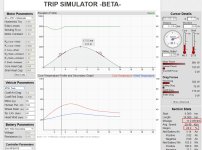
With regen enabled and a 40 kph speed limit riding in a tuck position, we use 11.2 wh/km and get about 22% regen doing the trip in 21min 13sec (screen capture above taken with slightly different parameters than URL link):
https://www.ebikes.ca/tools/trip-simulator.html?m=M2707_SA&v=cust_ad0.4_rd0.008&ms=90&h=100&w=26&sp=40&wv=0&b=B5216_GA&c=cust_pl75_rl75_bl25_cr0.02&rg=true&t=21&ct=21&st=21&i=evd&s=st&p=16A08862FN9V
Meanwhile, if the speed was limited to 30 kph instead of 40 kph, then you'd get an amazing 56% regen and use just 7.3 wh/km in 27m 52s
https://www.ebikes.ca/tools/trip-simulator.html?m=M2707_SA&v=cust_ad0.4_rd0.008&ms=90&h=100&w=26&sp=30&wv=0&b=B5216_GA&c=cust_pl75_rl75_bl25_cr0.02&rg=true&t=21&ct=21&st=21&i=evd&s=st&p=16A08862FN9V
So those are some benchmark numbers for a regen enabled system using a generic direct drive hub motor, with both 40kph and 30kph cruising speeds.
Now lets compare this to a mid-drive BBS02 system. Here it doesn't make sense to compare in the same manner where we go up and down the hill at the same speed since that's not how you'd use a mid-drive. What we want to do is climb slowly in a nice and friendly gear, and then on the downhill stretch where there is no means of recapturing regen energy we go as fast as the hill allows, and to be fair we need to choose that climbing gear such that the total trip time is the same as with the direct drive motor. Unfortunately we haven't yet implemented a 'motor freewheeling' feature in the trip simulator so for now we'll divide the trip into the uphill and downhill sections.
To simulate freewheeling on the downhill stretch, I've put a motor phase current limit of just 2 amps, and from the 7.5km point to the end we cruise down pretty fast averaging 52 kph taking a total time of 7min 28 sec:
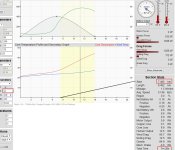
https://www.ebikes.ca/tools/trip-simulator.html?m=M2707_SA&v=road&ms=90&h=100&w=26&sp=70&wv=0&b=B5216_GA&c=cust_pl1_rl30_bl25_cr0.04&rg=false&t=21&ct=21&st=21&i=evd&s=st&p=16A08862FN9V&x=&y=&lx=591&rx=487&rw=700
Then here comes the fun bit, which is figuring out how most efficiently to do the hill climbing half using the BBS02 such that we end up with the same average speed as the previous sims with the DD hub motor. To compare against the 40kph case with the DD hub, we need to do the climb in 21m 13s - 7m 28s = 13m 45s, and find the effective gear ratio that will achieve this, which we can do using the "run simulation set" feature. Here we're simply varying the wheel diameter since there isn't a separate "gear ratio" input yet for mid-drives but changing the wheel size has exactly the same effect

With the resulting data plotted we see that a wheel size of 51 inches gets us the hill climb in the target 13.75 minutes, so that our total trip time up and down the hill is 23 mins 24 sec, same as with the DD motor and regen.

https://www.ebikes.ca/tools/trip-simulator.html?m=MBBS02&v=road&ms=90&h=100&w=51.3&sp=40&wv=0&b=B5216_GA&c=cust_pl75_rl75_bl25_cr0.02&rg=true&t=21&ct=21&st=21&i=evd&s=st&p=16A08862FN9V&x=&y=&lx=0&rx=238&rw=487
The net result is that the hill climb with the BBS02 motor geared optimally for 13min 45 sec requires 148.2 Wh
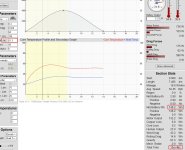
Over the full trip including the downhill coast, that works out to be 148.2 Wh / 13.9km = 10.6 wh/km, which is in fact a bit better than the DD motor with regen (11.2 Wh/km). So in this particular example the regen gained on the downhill portion doesn't _quite_ compensate for the reduced motor efficiency while climbing, and the mid-drive setup has better net mileage.
On the other hand, if we used a more efficient GMAC motor instead of the generic DD hub motor, then the that same trip uses 10.3 wh/km and gets 25% regen
https://www.ebikes.ca/tools/trip-simulator.html?m=GMAC10T&v=cust_ad0.4_rd0.008&ms=90&h=100&w=26&sp=40&wv=0&b=B5216_GA&c=cust_pl75_rl75_bl25_cr0.02&rg=true&t=21&ct=21&st=21&i=evd&s=st&p=16A08862FN9V
In this case it gets better mileage than the BBS02 mid-drive.
You can use this method to play "what-if's" on all kinds of scenarios, and find all kinds of hill grade and speed situations where a particular mid-drive motor has better net efficiency, and all kinds of situations where a regen capable hub motor has better net efficiency. There isn't a simple rule of thumb answer. But my own observations both analytically (like the above example) and empirically is that most of the time a well optimized regen setup (like the GMAC + Phaserunner) generally has an edge over a mid-drive like the BBS system when riding in hilly terrain.


